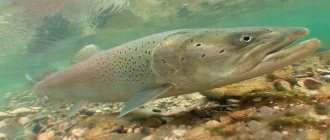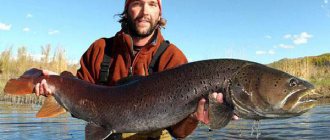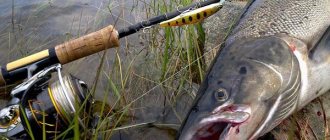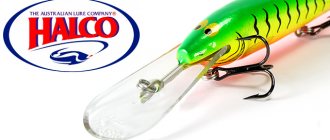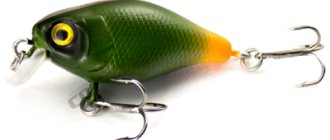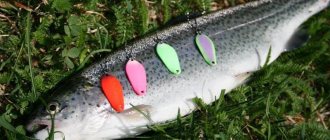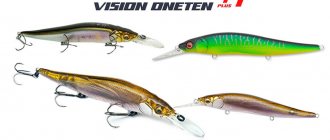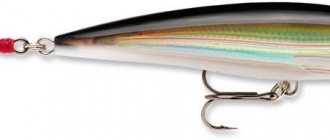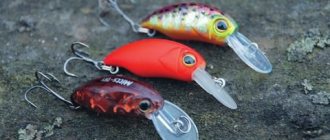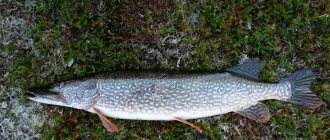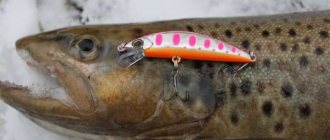Tackle for catching taimen
All tackle used in practice for taimen are distinguished by increased strength characteristics. The most popular and widespread fishing for predators is using a spinning rod. With a powerful spinning rod, equipped with a power reel with a well-functioning friction brake, you can count on a successful outcome in the fight against a twenty-kilogram trophy. For these purposes, forms are selected 2.5-3 meters long, with dough from 35 to 50 grams. The most practical gear is medium action, which allows you to find the optimal parameters for bait control and compensate for overloads when playing large fish in rapids. For spinning, choose a power inertialess mechanism of 4500–6000 units or a multiplier version of the mechanism close to these characteristics, equipped with a monofilament line that better withstands the requirements of fishing on abrasive bottom grounds.
Fishing for taimen is much less common with fly fishing gear. The parameters of the whip are chosen according to the size of the fish, and therefore, they are equipped with the most massive gear of class 10–12, supplementing them with special medium-sized inertial reels with an adjustable ratchet brake. In specific places it is possible to use such gear as a boat and even a live bait float rod
When equipping installations, attention is paid to the thickness of the fishing line, which can withstand excessive loads and effectively resist abrasion on pebbles and rocky bottom soils. Hooks sharpened to perfection will help you reliably hook and hold massive fish that are frisky while playing, preventing them from getting away.
Fishing for taimen in May using a spinning rod
Spinning can easily be called the best tackle for hunting taimen. It is very versatile and allows you to fish any size fish in a wide range of conditions.
There is also a fairly wide variety of baits and techniques for presenting them, and this is an important condition for successful fishing.
Spinning rods for catching taimen in May
The standard option for taimen fishing is spinning rods with a test range of about 40-100 g. The greater the depth and the stronger the current in the fishing area, the further you need to cast the equipment, and the larger the fish that is supposed to be caught, the higher the test range should be.
The length of the spinning rod can be from 1.5 to 2.7 m. Larger sticks allow you to make long casts and provide more opportunities to control baits on the retrieve. But long spinning rods are inconvenient to use from a boat or when fishing from shores overgrown with trees and bushes. Also, their use does not make sense when catching taimen on small rivers. Thus, in these conditions it is preferable to use shorter rods, up to 2.1 m. The most universal spinning rod length is 2.2-2.4 m. With such a rod it is quite comfortable to catch taimen in May in a variety of conditions, both from the shore and from the boat.
If you plan to catch trophy-sized taimen, the best choice would be a baitcasting reel. Models of this type have two significant advantages:
- they make it easier to land large fish, since they have a large traction force (they work on the principle of a winch) - dragging a weighty trophy out of the water is easier with them than with conventional inertial or non-inertial ones;
- The multiplier can withstand heavy loads well; in trophy fishing, it turns out to be more durable than other types of reels (of course, if we are talking about a high-quality model, which cannot be cheap).
However, inertia-free ones can also be a good choice. Models with sizes of about 3500-7000 are suitable for catching taimen. The smaller the fish that are supposed to be caught, the more relevant the inertia-free approach is.
If you plan to catch taimen by trolling, you can acquire one or more gear in this direction. Typical trolling rods perform very well when playing, they tie up fish perfectly. At the same time, their throwing qualities are not so good, but this is not required for trolling. As when catching taimen by casting, it is preferable to use multiplier reels, but spinning reels are also suitable.
Trolling fishing is interesting because it brings the maximum number of solid trophies. Large predators are much better caught by trolling than by casting
On the one hand, this suggests that this method of fishing is worth paying attention to (besides, it is not as complicated as it might seem at first glance). On the other hand, powerful gear equipped with baitcasting reels is best suited for hunting taimen, and such trolling gear is available for sale in large quantities
But you can also use the same conventional spinning rods that are used for casting fishing. Most fishermen do this, at least when they first start trolling. If you want to develop further in this direction of fishing, you can acquire special trolling gear, or better yet several.
Technique for catching taimen in May using a spinning rod
No special tricks are required when catching taimen using a spinning rod. The main thing is to choose the time when the fish is active, then find it in the pond. Then you need to deliver the bait to the point using regular, standard animations.
Among the fishing rods for catching taimen in May you can use:
- uniform - for spinners, wobblers and mice;
- wavy - for spinners;
- stop-and-go – for wobblers;
- pelagic jig - for spinners;
- bottom jig - for spinners.
In Russia for taimen. Part 1
Alexander Tolpyshev.
Taimen 13 kg caught on a Serbian wobbler from the master CIKA. June 16, 2019
There are probably no spinning anglers in Russia who do not dream of flying on an expedition for taimen at least once in their lives. Taimen fishing has become a cult over the last 6-7 years, and prices for tours are getting higher and higher from year to year. However, despite all the financial difficulties, the number of applicants is not decreasing, but on the contrary, there are more and more of them. To get to some rivers in certain regions, people sometimes wait in line for 2-3 years, paying an advance or the full cost of the tour in advance.
Khabarovsk region.
More than 10 years ago I became acquainted with taimen fishing, and it hooked me so much that I decided to connect my future life with it. There were no retail fishing stores in our market that specialized in this narrow and at the same time complex area. In 2014, I filled this empty niche. It was a long and thorny path, but now, I can say with confidence that there are few lovers of salmon or taimen fishing who would not know about the Rybalka-777 store, or about the Tours-777 website.
When selecting an assortment for the store, I listened to the opinions of seasoned time hunters and turned my attention to handmade Serbian wobblers. A caveat should be made here: not every “Serb” will catch well. We needed products from proven and well-established craftsmen. Fortunately, I got my hands on time with a catalog from Beorn, a company that supplied Serbian wobblers to Russia. It contained the phone number of Branko Arandjelovic, a most worthy person, whose cooperation turned out to be very fruitful.
We immediately got down to business, and after 2 years, certain masters became very popular in our country, and the names Nikola Kosich, MADA, Zile, GOLDY, Zvonko, Max, M.A. (Taimen Hunter), Cika, Calypso, Monarch became widely known among timeshakers. Master Mato was also famous for the time being, until he lost ground in terms of the quality of his products.
Adherents of taimen fishing have always been divided into those who unconditionally believe in Serbian “pieces of wood” and those who do not recognize them. They say, how do these Serbs know what taimen bites on? I strongly disagree with this point of view. Firstly, Serbia and neighboring countries have their own - the Danube taimen, which practically does not differ in habits from ours - the Siberian one. Well, secondly, some masters are still familiar with our taimen, and I personally introduced them to it. Actually, this report is dedicated to this acquaintance.
Several years ago, Branko and I invited the best craftsmen from Serbia for a joint trip to the Khabarovsk Territory. The best week on the Burlit River was booked in just 7 minutes on the phone. Unfortunately, not everyone was able to come, but we still assembled a team. It included the American Jan Forszpaniak, the founder of the GOLDY company Milomir Starčević Mišo, Nikola Kosic, Mato, Ivan Mujević, Branko, Mikhail Skopets and me. Mikhail Skopets and Jan Forszpaniak are not random people. Mikhail Skopets is not just a world-famous ichthyologist, but also one of the few who seriously catches trophy taimen by fly fishing. Well, our American friend Ian is a multiple IGFA record holder. It must be said that he, like our Serbian friends, was in Russia for the first time.
So, go ahead towards your fishing dream! Perhaps this is the most correct definition for hunting taimen. My friends and partners met us in two Lexus cars and a Toyota Hiace minibus. We quickly loaded our bags and went to the hotel, where we stayed for just a few hours to wash up, have a little snack, and in the late afternoon we hit the road again to a remote settlement, which will take no less than 8-10 hours.
And this is not counting stops at roadside cafes. Of course, it was possible to save effort and time and use a helicopter transfer, but then the already considerable cost of the tour would have at least doubled. The road to the rivers where taimen live is always difficult. And in most cases, it is impossible to reach them by car. However, if such an opportunity exists, my guys from the ZaTaimenem company always use it. They are true professionals in organizing fishing tours along the rivers of the Khabarovsk Territory.
And now, finally, the long journey is over. "Finish!" - as Branko said. Next came loading onto the ship and a three-hour journey along the Amur towards the secret place, and after that, another hour of travel in our jeeps and bus through the taiga. At the appointed place, boats equipped with water cannons were waiting for us, on which we quickly reached the stationary camp prepared in advance for us.
Amur river.
Amur river.
Amur river.
Upon arrival at the “base,” we quickly dropped our things and immediately set the table. Having had dinner, most of our group began to get ready for bed, however, there were also a couple of impatient ones who immediately went fishing. Let me note that they were not catching with mice (they don’t catch them in Serbia), but with Serbian wobblers, and almost immediately they showed up with large lenkas. Judging by the screams coming from the shore, you would have thought that they had broken the IGFA record...
Taiga.
Taiga.
First day.
Taiga.
Waking up, we quickly had breakfast, got dressed, prepared our gear and immediately went fishing. The beauty of the taiga and the abundance of promising places caused a pleasant jitters. However, the bite did not start immediately. Moving along the river, we radioed to each other about the checked points and the results of their examination.
The main purpose of the trip was to show the performance of handmade lures in various conditions - on the current, in lulls and in difficult places for fishing. And of course, catch big fish with them. Fortunately, the water level and weather were perfectly conducive to my plans.
All team
I’ll be honest: Serbian wobblers exceeded my expectations on the first day. The baits behaved well in the water and regularly brought me large lenkas. The fish were actively caught with large baits, and I, in turn, was not shy in choosing them, and placed pieces of wood 15-18 centimeters long. The receiving party - the guides and two owners of the ZaTaimenem company, Alexey and Valera, were shocked by my methods, and said that no one had ever caught such a size here - they say, this is “Not Tugur”. Meanwhile, Japanese famous baits from Smith, Daiwa and DUO occasionally caught timeshata. Lenki were also caught, but not nearly as large as those that pecked at the “Serbs.”
Alexander T. Lenok but Serbian wobbler master M.A. (Taimen Hunter) 15cm.
Alexander T. Lenok on a Serbian wobbler Calypso 14cm.
Saruna only collected small change.
It is quite difficult to retell everything that happened over 7 days, but I will try to describe in this report the most important and bright moments of our trip.
Beginning time fishermen do not know, and it would not be amiss to say, that the first day, and sometimes the second, is a kind of reconnaissance, and only after this reconnaissance comes an understanding of the conditions under which you will have to fish and where to look for fish. Looking ahead, I note that on this trip only those who strived for it and those who had enough experience caught a trophy. But in most cases, the result depended on the goals set. For example, Nikola Kosich generally said that he doesn’t care about taimen. He caught it for 30 years in Serbia, and on this trip he decided to devote all his time to the lures that he created for catching lenok. Meanwhile, many taimen fishermen know that Nikola’s wobblers are considered the best for catching taimen in Russia. All records over the past few years in Khabarovsk, Yakutia, Krasnoyarsk and Mongolia were taken precisely from them...
Master Nikola Kosich.
I focused on wobblers from Cika, MADA, and Misha Starchevich. Of course, I also used wobblers from Kosich, Mato and Gilet and new masters, but not so actively. As a result, I caught several lenok and several medium taimen, most of which were caught on an orange wobbler from MADA. Also, I managed to miss the trophy on the very first day of fishing. It was clearly a taimen weighing more than 30 kilograms, which grabbed the wobbler of the Cika master, and swam against the current straight into the hall, where it successfully hooked the bait onto a snag and swam away about its business. I assumed that if a fish bit in this place, there would be little chance. I was overwhelmed with a lot of emotions... I fought with the taimen for 5-7 minutes, and he beat me...
Hall.
After this episode, it became clear to all the guests that there were giants in this river. Master Michaud (GOLDY) was with me in the boat and what happened inspired him a lot. Michaud is an experienced time hacker. For more than 20 years he has been catching taimen in Serbia and neighboring countries, and has been to Mongolia three times. It was his first time in Russia, and as practice has shown, there are different fishing conditions here. The most promising places on the Burlit River, from the holes to the mouth, are strewn with snags and sunken trees, which greatly complicates the fishing process. But experience is experience: during the next move along the river, Michaud noticed an interesting place five hundred meters from the camp. On the way back, he asked the guide to turn back to the “base” for exactly 5 minutes to change clothes, after which, while the guys were setting the table and getting ready for dinner, we went to the place that interested him to make a few casts there. The master's eyes did not deceive him: the place was excellent. And on the 11th cast there was a bite. The fight lasted 15-20 minutes and ended in favor of the Serb. It was an excellent trophy, caught by the master using a one-piece wobbler of his own making. However, he did not catch with other baits - only with those that he made himself.
It would not be amiss to note that Michaud cooperates with Rybalka-777, and makes 150 wobblers a year for me. You can get acquainted with Michaud’s work and purchase GOLDY wobblers at the link fishing-777.ru/…/view/447.
Master Goldie and taimen for 20 kg.
Master Goldie and taimen for 20 kg.
Handmade wobbler from master Goldie.
Since 2014, I annually prepare and send 3-5 teams to the Burlit River, and keep detailed statistics on the places and times of captures, and of course, on working baits. I won’t hide that sometimes serial Japanese lures also work, but practice has shown that it is the wobblers of MADA, Cika, Nikola Kosich, GOLDY and MA (Taimen Hunter) that break all records. Whoever controls the statistics controls the situation, and the capture of Michaud is a clear example of this. Guided by the data I provided, within 4 months he replenished his boxes with unique wobblers, and the result was not long in coming.
When Michaud caught his trophy, our joyful screams were heard right from the camp itself! The capture of a trophy taimen by one, and a worthy catch by the second member of the same crew - this is a significant result for the first day! Returning to the camp, we proceeded to dinner and discussing successful fishing at the table, as it should be in good company.
The magic of the taiga.
End of the first part. Photo: Alexander Tolpyshev. All rights reserved. Copying materials without written consent is prohibited.
Fishing for taimen with a spinning rod
To successfully catch taimen, the tackle must be compact, since you will have to walk along the river for quite a long time in search of this predator. The rod should be at least 3.5 m long, light, but quite strong, preferably two-handed, since taimen is a large fish, the guide rings should be made of strong steel wire. The action of the rod is slow, medium and fast.
Spoon
Fishing line is used with a diameter of 7 mm or more or braided line with a breaking load of 14 kg or more. The reel is taken to be an inertial or multiplier reel, powerful and of high quality, always with a friction brake, the size of the spool should allow you to wind 100-150 m of fishing line, such a reserve will be needed when fighting taimen, read more about choosing a reel here. Carabiners for connecting gear should be made of brass or iron, having a frame shape.
Fishing for taimen occurs with the following types of bait:
- live bait;
- spoon;
- mouse;
- wobbler
After spawning, during the period of feeding, the taimen is rather indiscriminate in its choice of food and therefore grabs almost everything that is given to it. But then it becomes very capricious, which is why the fisherman must have in his arsenal many spinners of different colors and shapes.
Read How to catch chub with a spinning rod and choose the right model
When fishing in deep water or fast currents, you should use heavy spoons 10-12 cm long.
When fishing at shallower depths and in small currents, rotating spoons of large and medium sizes are used. It is advisable to choose the color of the baits similar to the color of the fish that live in the reservoir and serve as food for taimen. The most popular are brass spoons that have a yellowish tint. In cloudy weather they catch with polished ones, in clear weather with uncleaned ones. The weight of spinners reaches 25 grams on average, so the rod test should be in the region of 20-50 grams. and more, especially when fishing with an artificial mouse (test 60 - 85 g). The spinner is deployed in the bottom layers at an average pace. Biting taimen can be confused with hooking on a log or stone, the only difference being that after a few seconds there will be a sharp jerk. In cases where catching taimen with a spoon does not produce results, you can try fishing with a wobbler. It is better to use a noise wobbler with a immersion depth of up to 1 m. The length of these wobblers is 12 cm or more, they are slanted and narrow.
Tackle for taimen
Spinning fishing. The most popular tackle used for catching taimen is a spinning rod. The spinning rod for catching this salmon must be very strong. It is advisable to use a two-handed stick, at least 3.5 meters long. Such powerful tackle is needed because taimen reaches truly impressive sizes, and even not the largest specimen can give the fisherman such a fight that not every spinning rod can withstand such a load, and sometimes fishing for taimen lasts for hours.
The fishing line is used with a diameter of 0.7 mm and above. A thinner line runs the risk of being torn after the first bite. There is absolutely no need to use a metal leash, since taimen are not able to bite the fishing line with their sparse teeth. Due attention should be paid to the hooks. They must be very strong, because weak hooks are often broken by the powerful jaw of the taimen. Also, when catching taimen, you cannot do without a high-quality, powerful reel that will hold enough fishing line to starve out the fish. You must set up the reel and drag in advance so that it can easily absorb the powerful jerks of the salmon along with the spinning rod.
How to catch taimen
Once again, we emphasize that fishing for taimen is limited by law and the fisherman bears considerable responsibility for the future of this fish. Therefore, regardless of fishing methods, it is reasonable to conduct production according to the catch-and-release principle, without causing harm to the population of a rare species and promoting its further survival in natural conditions
Despite the fact that spinning takes a leading position in taimen fishing trips as the main fishing tool, from region to region one can observe local approaches to catching the predator. In the continuation of the article, we will consider a number of technologies for obtaining this coveted trophy, starting with the most popular and moving on to more exotic fishing options.
How to catch taimen using a spinning rod
Fishing for taimen with a spinning rod can be carried out in two directions: coastal hunting and hunting while rafting down the river on a motor boat. Coastal hunting in often impassable places is difficult and does not always provide the spinner with the opportunity to fish promising areas, being content with fishing in small areas approaching the water. The boat significantly expands the possibilities, which often becomes the key to success. On a motor they rise against the current, catching promising points by feeding bait against the flow of water. The predator is not very timid and, confident in its invulnerability, rarely leaves the hunting grounds due to the noise of the engine. A spinner can be successful even if his camouflage is not particularly thorough.
The main thing is to correctly determine where the fish are staying and lead the bait close to the bottom, allowing them to play through the flow of water. Large individuals prefer massive and heavy baits. Small spinners will fall prey to lenok or perch, as well as undergrowth like a couple of kilos of timefish. In riffles and shallow waters they fish from the surface, floating imitations of mice and feeding poppers to the predator. In water areas with pike, metal leashes are installed in the rig, otherwise the spinning angler faces frequent cuts from the bait of the catfish, which competes with other predators.
Fly fishing for taimen
You can fly fish for taimen in the fall and summer using an artificial mouse. They go out for fly fishing with mice closer to dusk and at night. The delicate tackle catches large, highly resistant trophies, so the equipment uses long backing, which allows the fish to escape a couple of tens of meters. In addition to mice and popper-type wobblers, streamers identical in appearance to salmon fishing, intruders, artificial leeches, fly wobblers and fly spinners are suitable for fly fishing. Taimen prefer fly baits in natural dark colors.
Fishing in other ways
Of the alternative tackles, the most popular is a boat, released with bait in the form of an artificial fly, an oscillating spoon or a soft mouse. Local residents, with centuries of accumulated experience, successfully hunt the giant using props and hooks of various designs. As bait, these specific tackles are equipped with live bait or a bunch of large worms, feeding the rigs into the fishing zones tested by the fisherman. Often, float-based live bait fishing rods are used for these purposes. On lakes and large rivers, catching the predator by trolling is quite successful. A well-chosen working wobbler for taimen is led over promising sites for the predator, picking up especially large active individuals that react to the sharp play of the bait.
Fishing for taimen
The predator is quite aggressive when playing, moreover, large fish are incredibly strong and can easily crush flimsy tackle, not forgiving of delays in reeling in a loose cord, gaining some freedom of action and maneuver for a jerk. After poking the bait, you should make a test mark, securely place the trophy on the hooks, and immediately begin pumping out fish
It is important not to allow the predator to retreat to cover, which is often a nearby dead tree or underwater rock ridge, from where it will be almost impossible to remove densely entrenched taimen
Often, a powerful candle at the initial stage of fishing allows the fish to spit out the hooks, so you should constantly keep the line tight, gradually tiring the fish, while simultaneously working with the rod and reel to pump out and reel in the released line. Despite its massive size, taimen is a rather delicate fish, sensitive to oxygen starvation and microtrauma from a hook, and even more so from a hook. It is recommended to hold the caught fish for as little time as possible, take a couple of wonderful photos and release it back into the river stream.
What bait should I use?
Judging by what is found in the stomach of the river giant, we can conclude that the predator attacks everything that floats and comes into its field of vision. However, this does not mean that you should ignore bait for taimen, which will ensure a positive result when going into the taiga wilderness for the desired trophy. Taking into account the power and size of the owner of taiga rivers, baits for catching taimen are used in appropriate sizes - from 10 to 12 cm. These can be rotating, oscillating spoons, as well as wobblers. The choice of one bait or another directly depends on how the river tiger will be caught:
- a large, weighty spinner bait for taimen (“Kola”, “Svinka”) is suitable for use in deep-water areas of the reservoir;
- in shallow water, experienced fishermen recommend using medium and large rotating spoons (Baikal, Kem).
Recently, jig baits have begun to be used - a wobbler for taimen with a diving depth of up to 1 m, an elongated body of up to 12 cm.
Photo 2. Red and white wobbler.
An equally effective bait is an artificial mouse. Of course, you can buy such bait in a store, but it’s better to make it yourself, especially since it won’t be difficult. A foam cone 12 cm long must be weighted with a lead plate so that the total weight of the bait is 60 g. Then wrap it in faux or natural fur, and then attach 2 tees. It is advisable to catch taimen using a mouse at night. The bait, as a rule, is thrown downstream - it produces a characteristic slap when splashing down, which does not go unnoticed by the river “tiger”. Then the wiring is done. Moreover, fishing with a mouse is good with slow retrieval.
Photo 3. The mouse is one of the most catchy baits for taimen.
Winter fishing
If you do not pay attention to the opinions of numerous fishermen who consider taimen to be an exclusively heat-loving fish, you can convince yourself that taimen can be caught in the winter season, and the bite can continue throughout the entire cold period of the year.
Thus, catching taimen in winter becomes possible under certain conditions, which should be carefully studied if you want to catch excellent fish. But it is worth knowing that taimen are more likely to be caught in the northern regions of the country during winter.
Finding taimen is not a difficult procedure, since in winter the water in domestic reservoirs is quite transparent and clean, as a result of which it becomes possible to observe fish at depths that are inaccessible in summer. Taimen, by their nature, are accustomed to staying apart, which is why, if one salmon representative is successfully caught, it is not advisable to expect a bite in the same place.
Read DIY self-hooking winter fishing rod
Thus, the design of the girder, consisting of a strong fishing line and a tee wound on a reel, is quite acceptable. The reel is fixed on the ice with all the care that is inherent only to you, otherwise the whole fishing is jeopardized. You can tie the reel to a wooden block, but you will have to place it in the hole in a transverse position.
When it comes to choosing the optimal live bait for catching taimen in the winter, you should know that the main bait is usually large roach, lenok, or grayling. When choosing bait, you should still give preference to lenok, since it is the one that is able to remain active for a long time, which cannot be said about its “competitive alternatives.” It is worth remembering that it is advisable to check the tackle once a day.
What gear is needed to catch fish?
The presented fish are mainly caught using spinning rods. If the current is fast, it is necessary to use oscillating heavy spoons, whose thickness reaches 3 mm. In deep places, 1.5 mm spoons and sinkers are used. In quiet waters, light 1mm spoons are required. The bait is taken with a fish color, and the best option is a brass yellow spoon, which is clearly visible in any light.
Roach in June 2021: rules and features of fishingCatching crucian carp in June 2021: an unpredictable activityPerch fishing in June 2021: an exciting and challenging activityBream fishing in June 2021: rules, tips, nuances
When using wire, you must be extremely careful not to break it. In this case, the bait is lowered rather than thrown
The sinker will have to be attached to a separate leash on a triple swivel. The leash used is nylon with a diameter of 0.6 mm.
Spinner for salmon
Most often, when fishing for salmon, oscillating spoons of large weight and length are used, the performance of which directly depends on the strength of the current, width and depth of the reservoir.
It is generally accepted that a salmon lure should touch the bottom the first time it is cast across the current. The angle of the fishing line in relation to the bottom is approximately 45 degrees.
In such conditions, the wiring will be attractive to the predator, and the chance of snags will decrease.
We have compiled a short list of the most catchy lures for salmon
Much attention was paid to salmon spinners from the Kuusamo company, which showed their high efficiency in catching salmon, pink salmon, taimen, grayling, trout and even pike. Naturally, these lures can easily catch other types of fish, but time has shown that their calling is salmon fishing
Other types of spinners
Spinner baits with hooks protected from snags or, as popularly known, “non-snagging” hooks will help you catch perches from the deepest underwater forests of water lilies and algae. But due to the closed hook, the number of effective bites will be very different from empty bites. Spoons find their use mainly in such situations, and if possible it is better to use other baits that the perch will bite better on.
Some people make a montage of several small silver vibrators at once, thereby simulating a small flock of fry. This kind of perch fishing gear is useful for large schools. With a good bite, you can pull out “doublets” on it.
To summarize, let's say that perch is the least capricious fish in terms of baits. If the place where the flock is located is correctly selected, we select the bait by rinsing it in the water and enjoy pleasant pokes, as well as no less pleasant fishing.
Selecting a location
The taimen's range extends to Siberia, the Far East, Altai and northern Kazakhstan. But at the same time, northern areas and reservoirs located as far as possible from civilization are more promising for fishing. In the south of the taimen's range and near large cities, its population has been thoroughly thinned out, and getting good catches here is not easy, and catching a trophy specimen is unlikely.
Fishing for taimen in July is most successful in fairly fast-flowing rivers with cold water, the length of which is 300-400 km. In the spring, going to spawn, this fish rises to the upper reaches of rivers. Then the taimen drops a little lower, but, as a rule, it’s still not worth looking for it in the lower reaches of large rivers. Since this fish loves cool weather, in mid-summer it stays where the flow is fast enough and temperatures are low.
In order for taimen fishing in July to be successful, you must first fish different interesting areas where the river flow is disrupted.
Promising points for such fishing will be:
- rifts (thresholds);
- reaches below the rifts;
- spits, arrows, underwater ridges;
- pits (entrances to pits and exits from them);
- other sharp changes in depth, edges;
- rocks and boulders located in the water;
- whirlpools;
- merging streams located below the islands;
- places where tributaries flow into the main body of water.
This fish prefers to stay in relatively calm sections of rivers with a fairly large depth. Depth is especially important for large specimens. They prefer to hunt on the riverbed, and go under the banks if there are holes or simply great depths (which are usually located under steep ravines). Taimen can enter shallow creeks for their prey during periods of active feeding, that is, most likely in late spring, early summer and autumn.
Where to catch taimen. Promising places.
Taimen rises to the upper reaches of rivers only during spawning, and the rest of the time it tries to stay in the lower and middle parts of the river. First of all, you need to look for taimen where there is a lot of food for it, and its main food is other, smaller species of salmon, such as whitefish and grayling. If you find a place where a decent number of such small salmon have gathered, then there is almost no doubt that you will also find taimen there. As for the bottom topography, start fishing those places where the water not only maintains a smooth flow, but where there are various obstacles and obstacles in the way of the water. Most often, taimen spins in the following places:
- whirlpools;
- reach:
- deep holes;
- thresholds;
- arrows;
- braids;
- sudden changes in depth;
- rocks protruding from the water;
- underwater ridges;
- at the confluences of large and small tributaries;
- near the boulders cutting the current.
Here the taimen is looking for something to profit from, and it is in such places that the small fish that the taimen feed on live. Small and medium-sized taimen like to stay in groups and only large individuals prefer solitude. It is not for nothing that they are also called red pike, because their habits, as well as the structure of their jaw, are similar.
Spoons
One of the oldest and at the same time popular methods of catching this predator is fishing with iron. Taimen spinners demonstrate very high efficiency, and due to the diversity of their shapes and varieties they can be used in a wide variety of conditions. Lures of this class are divided into two main types: spoons and spinners.
Hesitating
This type of bait is excellent for fishing in mountain rivers, since the current enhances their play, and the weight allows them to be cast far enough. The color of the spoon is chosen depending on visibility in the water: if the water is crystal clear, it is better to use colored baits in neutral tones: white, gray, copper. In conditions of limited visibility and muddy water, it is best to give preference to shiny silver and golden spoons.
Read The best catchable baits for asp
When fishing in conditions of good visibility, experienced fishermen recommend using lures not coated, but made entirely of unpolished copper. Their matte reddish color has a positive effect on the interest of fish.
The choice of the size of such a bait is an important and serious point, since in mountain rivers slightly smaller fish, lenok, also readily bite on them. In most other situations this would only be a plus, but in this case this factor cannot always be considered positive
The fact is that by making about ten casts, and even more so by pulling out a couple of fish, you can scare away a cautious predator from the fishing spot, after which you will have to either move upstream or wait quite a long time for the bite to resume
Many companies make special spinners aimed specifically at taimen. A striking example is the thirty-gram Mepps S DE MER, which, according to the manufacturer, has ten shaping planes, which improves the play and refraction of light. One way or another, this spinner, which is a modification of the well-known SYCLOPUS model, is popular among fishermen.
More budget options also work well, such as the Koleb-stand Taimen from Helios. Its weight is 18 grams, and its dimensions are excellent for catching both taimen and large lenok. This is a brass spoon with a scale-shaped relief applied to it, which allows it to refract light in an unusual way.
Oscillating spoons for lenka and taimen differ, for the most part, only in size, therefore, if an angler is hunting for a trophy, the size of his bait should be at least 10, and preferably 12 centimeters in length. If he is satisfied with lenok in the by-catch, you can also use smaller spoons - they work great on this fish, and small specimens of taimen will also not deny themselves the pleasure of attacking them. Such baits are used mainly in autumn and winter.
Oscillating spoons can also include such bait as castmaster. This thick, massive spoon is designed for fishing at fairly large depths, which makes it ideal for fishing holes and pools, so it is used mainly during the summer heat.
Rotating
Pinwheels are somewhat less popular among taimen fishermen than spoons, due to some difficulty in their animation at depth with strong currents. However, moderate water flows and still waters are excellent places to fish with such baits.
The color of the spinners is chosen according to the same principle as other spinners: depending on the transparency of the water. The size, in turn, is also quite significant: as a rule, these are numbers 5-6.
The petal shape of the spinner is preferably wide or medium, but the “willow leaf” in the case of catching taimen is not so popular. A big plus is the presence of feathers or woolen threads on the bait tee, which increases its appetizing to salmon.
The best time to use turntables is spring and autumn. The main advantage of these baits is that the depth and speed of their movement can be completely controlled, especially in the absence of a strong current. This helps to fish with them both in mid-water in the fall and closer to the surface in the spring, which is especially important in pebble shallow waters, where it is quite easy to tear off, for example, a spoon, hooking it on the bottom.
A popular spinner among taimen fishing enthusiasts is Blue Fox Salmon Super Vibrax 33 grams. It is available in nine colors, which allows you to choose the optimal one for a specific time and body of water. Size 6 makes it possible to cut off a significant part of insufficiently large fish and concentrate on catching trophies.
Fishing for Taimen
Fishing for taimen with spinning rod
Fishing for taimen with spinning rod
It is true that fishing for taimen using a spinning rod is a relatively new activity. The freshwater giant lives in hard-to-reach places - taiga rivers of Siberia, Altai, and the Far East. It is not possible to get here without the help of small aircraft (helicopter). The old-timers of these places catch the river “tiger,” as they call it, using their own methods, of course, without “sophisticated” spinning rods and expensive spinners. However, we’ll figure out where to look for taimen and what gear is best suited for fishing for fish. What bait to use, what tactics to use when hunting for taimen. We will also deal with other issues related to this topic.
Where is taimen found in Russia?
The habitat of our today's hero extends from the Trans-Urals to the Far East. The taimen fish is found in the basins of large Siberian and Far Eastern rivers, among which the Lena, Yenisei, Amur, and Lake Baikal stand out. The further north the region, the higher the number of this representative of salmon fish, and it is larger in size. Southern Siberia, the Sayan Mountains and Altai, once famous for their catches, have now lost their leading position in the number of taimen, and meeting them in the rivers of these regions has become a great rarity and incredible luck for a fisherman.
The fish avoids industrial areas near large cities and looks for secluded areas for living in calmer and cleaner waters, avoiding polluted reservoirs with low oxygen concentrations in the water. You can find a large population of the Red Book fish outside of untouched areas, remote from civilization, where, in principle, fishing tours are organized by a few agencies specializing in providing this type of tourist services.
Where does it live?
Taimen prefers rivers more than 300-400 km long, although in fact it can live in rivers much shorter in length. Moreover, the taimen are larger and more numerous closer to the northern regions, unless, of course, human access to these places is limited. Large taimen can be found in:
- Lena pool;
- Yenisei basin;
- Amur basin;
- Lake Baikal.
These are the most famous rivers in which you can catch decent specimens of taimen, and large taimen are also available in sufficient quantities in fast and cold northern rivers, where even people who have already been there are not always able to get to. It is impossible to get there without special transport, such as a helicopter, which is why the taimen were able to survive there. Where people have already become accustomed and have free access to taimen habitats, or there is none left at all, as in cities:
- Irkutsk;
- Krasnoyarsk;
- Peaceful;
- Ulan-Ude;
- Yakutsk, etc.
Or there is little of it left and large taimen can no longer be found there. Such places are mainly the regions of southern Siberia, such as Altai and Sayan.
Taimen fishing seasons
Fishing for taimen is possible throughout the year with varying success. The behavior of taimen can change depending on where it is, which must be taken into account if you want to catch this interesting fish.
Fishing for taimen in spring
When the water temperature is above 12°, taimen spawn, which occurs in the spring. Taimen rushes to the upper reaches of small tributaries, where it spawns on clean pebble soils. As a rule, spawning grounds are located very far from feeding areas, so in the spring taimen make long spawning migrations. A couple of weeks after spawning, taimen regains strength and begins to actively feed, at which time there is a high chance of catching a large specimen.
Fishing for taimen in summer
The beginning of summer is considered the most suitable time for catching taimen; at this time it stays in deep-water sections of rivers. It’s good if there are underwater springs in such places. At this time, the behavior of taimen changes, and along with this, the fishing technique changes. During the daytime, the bait must be placed near the bottom at medium speed, and at night near the surface of the water.
Techniques for catching taimen in June
To get a large catch of taimen, you need to know the technique of catching it. The bait will interest the fish if it moves at an average speed near the bottom. At night, you can conduct wiring near the surface of the water. A fish bite feels like a blunt blow.
Here's how to catch taimen in June on a deep-sea track with a spoon:
- The sinker sinks to the bottom.
- You should travel by boat at a speed of 2 km/h.
- The tempering depth is checked periodically.
If the bait is dead fish, it is necessary to move it through the river in different ways. If the current is fast, the boat is anchored, the bait is lowered, and after a while it is raised, then the procedure is repeated. You can simply lower the bait in the middle of the river and then slowly move towards the shore. You should hook the fish immediately; if a hook occurs, you need to pull the line and tap the rod.
